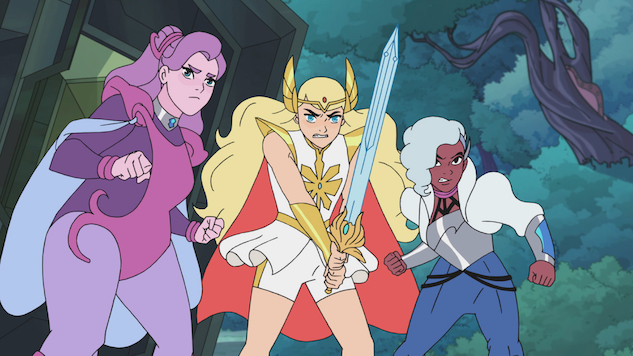5 Reasons She-Ra Deserves to Be Your Next Binge Watch
In which we apologize for taking so long to get on board She-Ra’s mighty rainbow bridge bandwagon.
Photos Courtesy of Netflix
The first thing you need to know going into She-Ra and the Princesses of Power is that there are way more robots than you’re probably expecting.
If you have even a passing familiarity with Netflix and Dreamworks’ thoroughly of-our-time reimagining of the legacy Masters of the Universe property, you might have been expecting me to lead with any number of other facts. Like say the fact that, led by the creative sensibilities of Noelle Stevenson, the graphic novelist behind Nimona and Lumberjanes, the series places both monster girls and the tender tenacity of friendship dead center. Or the fact that, also under Stevenson’s watch, the majority of the show’s creative staff and cast are female. Or the fact that—again, with Stevenson’s deliberate blessing—the new She-Ra is super, super queer.
But look. Before I finally sat down to inhale Stevenson’s She-Ra and the Princesses of Power to get ready for this week’s Season 4 return, I was the one with only a passing familiarity with this progressive ‘80s power ballad of a fantasy show, and those were all things I both knew and was looking forward to. The robots, though? Those were a total surprise.
So, I will say it again: If you, like me, are coming to She-Ra and the Princesses of Power for the first time—and you should; the magical mermaid princess water is lovely here—then whatever number of robots you’re expecting to see, be ready for double that. Possibly triple. Really, considering the nature of technology on/in Etheria, it’s probably best not to set any bar for how many robots might eventually cross your screen. Let the magic be in the discovery.
That basic groundwork laid, let’s use it to build up the real reason we’re all here: She-Ra-vangelism. She-Rangelism? She-Ra Evangelism. It doesn’t matter. Basically, She-Ra and the Princesses of Power, like so many of its animated contemporaries elsewhere on Netflix (The Dragon Prince; Voltron: Legendary Defender), Cartoon Network (Steven Universe; Adventure Time) and Disney (Gravity Falls; Star vs. the Forces of Evil), has been putting up season after season of compellingly nuanced stories about the power of friendship and mutual support over the forces of fear-mongering and hate that fans of all ages (and their families) can enjoy, and we want to make it as frictionless as possible for you to become one of them.
To that end, here are five (non-robotic) things we love about She-Ra and the Princesses of Power, any one of which might be the reason you finally take the Etherial plunge:
1. You don’t have to be familiar with the original to “get” what Stevenson and her team are about.
Now, this isn’t to say that everything about She-Ra and the Princesses of Power’s mythology will be clear from the start. On the contrary, most of the Big Questions you might have before “The Sword: Part 1” (Episode 1.01) is even over—what/where Etheria is; where the Horde comes from; what the Horde wants; where She-Ra’s sword comes from; what this world’s relationship is between magic and technology—don’t start getting answered until late in the second season. But as far as a new viewer’s ability to enjoy this new series goes, familiarity with the original isn’t at all required. On several levels, in fact, coming in fresh is ideal, as it won’t occur to you to compare characters and story elements, or to constantly be on the lookout for the arrival of He-Man. (Spoiler through Season 3: Never.) Bonus: You get to be surprised by all the robots!
That said, knowing it’s possible to get invested in Princesses of Power with zero She-Ra background and being ready to jump feet-first into a cult-favorite fantasy property whose fandom spans two wholly separate generations are two different things. So to help you out, here is the basic set-up of Stevenson’s version:
On the precipice of being named a Force Captain of the Horde, the ruthless military organization she and her half-feline best friend Catra (AJ Michalka) have grown up and trained in, an inherently kind human teenager named Adora (Aimee Carrero) stumbles upon a magical broadsword that sends her reeling into a vision. In that vision, an AI hologram named Light Hope (Morla Gorrondona) tells her that the whole planet of Etheria has been waiting 1,000 years for her to protect it by using the sword—and the honor of Grayskull—to become the mythical hero She-Ra. Upon waking, Adora is taken captive by one of the princesses of the rebel forces the Horde has trained her to hate and fear. On their way back to the princess’s palace, they stumble into several situations which lay bare the truth of the Horde’s callous, mercenary ruthlessness. This somehow being a complete surprise to Adora (don’t worry—her new friends are as baffled by that fact as you will be), she switches allegiances and joins Glimmer (Fukuhara), Bow (Marcus Scribner), and the rest of the Princess Rebellion to use love and friendship to fight off the Horde and all the evil they represent.
And… that’s it! Well, that’s obviously not it it. But in terms of being ready for the story Stevenson and her team weave together through the end of Season 3, that’s all you need. Etheria is supposed to be a mystery. The Horde is supposed to be inexplicable. The relationship between the sword/magic and technology is supposed to make you wonder. What you’re not meant to leave the first episode confused by is the complicated emotional relationships between the characters, which inherent tensions will lead to the other answers later down the line.
-

-

-

-

-

-

-

-

-

-

-

-

-

-

-

-

-

-

-

-

-

-

-

-

-

-

-

-

-

-

-

-

-

-

-

-

-

-

-

-











































